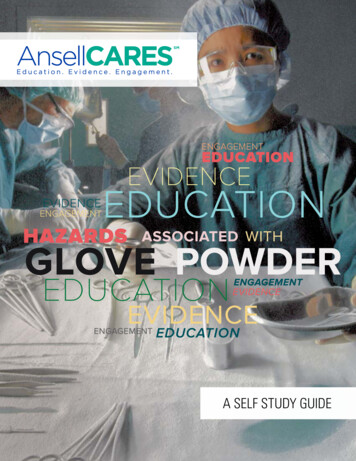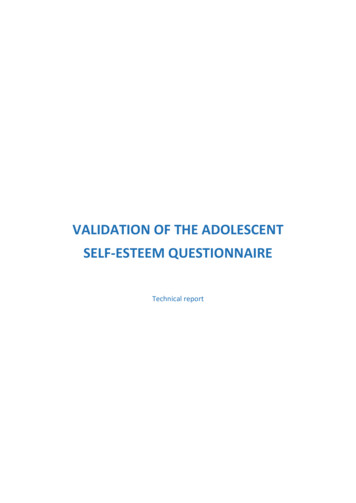
Transcription
A SELF STUDY GUIDE
OVERVIEWGlove powder includes dusting or donning powders, mold-release compounds, and manufacturing debris. Drylubricants such as cornstarch, silicone etc., are used to make donning gloves easier and to prevent gloves fromsticking together during the manufacturing process. Cornstarch, which meets the specification for absorbabledusting powder in the United States Pharmacopoeia (USP), is the most common lubricant for medical gloves.Only absorbable dusting powders that have an approved Premarket Approval Application (PMA) or NewDrug Application (NDA) may be used for lubricating surgeon’s gloves. There are no comprehensive studiesof the amount of absorbable dusting powder used on powdered gloves. It is estimated that amounts of totalparticulates may range from 120 to 400 mg for a medium size powdered glove. (FDA Medical Glove PowderReport). Glove powder is composed of particles, thus, issues related to biologic responses to foreign bodiesapply to both natural rubber latex (NRL) and synthetic gloves that are powdered.LEARNING OBJECTIVESUpon completion of this educational activity, the learner should be able to:1. Discuss the history of medical gloves2. Identify the donning agents used in medical gloves and their weaknesses3. Explain the risks and complications associated with glove powder4. Identify the costs associated with glove powder5. Describe how powder-free gloves provide a solution to powder-related problemsHAZARDSASSOCIATEDWITH GLOVEPOWDERINTENDED AUDIENCEThe information contained in this self-study guidebook is intended for use by healthcare professionals whoare responsible for or involved in the following activities related to this topic: Educating healthcare personnel Establishing institutional or departmental policies and procedures Decision-making responsibilities for safety and infection prevention products Maintaining regulatory compliance Managing employee health and infection prevention servicesINSTRUCTIONSAnsell Healthcare is a provider approved by the California Board of Registered Nursing, Provider # CEP15538 for 2 (two) contact hours. Obtaining full credit for this offering depends on completion of theself-study materials on-line as directed below.Approval refers to recognition of educational activities only and does not imply endorsement of any productor company displayed in any form during the educational activity.To receive contact hours for this program, please go to the “Program Tests” area and complete the post-test.You will receive your certificate via email.AN 85% PASSING SCORE IS REQUIRED FOR SUCCESSFUL COMPLETIONAny learner who does not successfully complete the post-test will be notified and given an opportunity toresubmit for certification.For more information about our educational programs or hand-barrier-related topics, please contact AnsellHealthcare Educational Services at 1-732-345-2162 or e-mail us at edu@ansellhealthcare.comPlanning Committee Members:Luce Ouellet, BSN, RNLatisha Richardson, MSN, BSN, RNPatty Taylor BA, RNPamela Werner, MBA, BSN, RN CNORAs employees of Ansell Mrs. Ouellet, Mrs. Richardson, Mrs. Taylor and Ms. Werner have declared an affiliation that could beperceived as posing a potential conflict of interest with development of this self-study module. This module will include discussion ofcommercial products referenced in generic terms only.2
CONTENTSOVERVIEW 2INTRODUCTION 4LATEX GLOVE HISTORY 5POWDERED LUBRICANT HISTORY 7TODAY’S POWDERS 9WASHING POWDERED GLOVES 9HEALTH AND SAFETY CONCERNS 11CONCLUSION 15ANSELL CARES 16BIBLIOGRAPHY 173
INTRODUCTIONBy the early 1900s the use of rubber gloves was common in thesurgical suite in both Europe and the United States. Althoughthe use of latex gloves in surgery became routine after WorldWar I, gloves such as examination gloves, were not consistentlyused in other areas of patient care until the onset of the AIDSepidemic and the spread of hepatitis.HAZARDSThe increased incidence of hepatitis B, (HBV), hepatitis C (HCV)and AIDS (HIV) infections in the early to mid-1980s resulted ina tremendous increase of latex examination gloves althoughalternatives such as vinyl and technology for various syntheticsexisted. Latex examination gloves were proven to be oneof the best methods of preventing transmission of HIV andhepatitis from infected patients to healthcare workers (HCWs).ASSOCIATEDWITH GLOVEPOWDERBy 1987, the US Centers for Disease Control and Prevention(CDC) instituted Universal Precautions (today called “standardprecautions”) recommending the use of personal protectiveequipment (PPE) such as gloves, masks, gowns, and eye shieldsto prevent transmission of bloodborne pathogens to save livesand prevent injury or illness in the workplace. This practice wasquickly mandated in many countries by healthcare authorities4
and professional healthcare associations around the worldand may have accounted for this tremendous increase in gloveusage. Between 1987 and 1996, the use of NRL gloves amongmedical professionals rose by more than 1000%(McCall, 2003; CDC). In 1986, about 1 billion disposable gloves were soldworldwide gloving-of-america.html). In 2001, more than 30 billion pieces, including both latexand non-latex gloves, are manufactured every year. Morethan 20 billion of them, representing over 1 billion inpurchases, are shipped to the United States. It is the singlelargest category of product sold by healthcare distributors.(Repertoire 2001). In 2008, more than 12 billion units of medical gloves weresold in the EMEA region.LATEX GLOVE HISTORYWilliam Halstead is the surgeon given credit for the introductionof surgical gloves in 1896. As chief of surgery at Johns HopkinsHospital, his nurse, Caroline Hampton (later to become hiswife), developed severe dermatitis from mercuric chloride,the disinfectant used to clean instruments and hands. As aresult, he asked the Goodyear Rubber Company to make rubbergloves. These gloves were developed not to protect the patientbut rather to protect the hands of those providing healthcare.Goodyear made two pairs of rubber gloves with gauntlets. Theyproved so effective in protecting Caroline Hampton’s skin thatthey became a common item used in the operating room.By chance Halstead’s glove request coincided with earlydiscoveries about the relationship between infection controland improved patient outcome. In 1847 in Paris, Semmelweisidentified a link between infection and death in maternitypatients cared for by physicians who were not washing theirhands. Further, in 1843 in the United States, Oliver WendellHolmes became an advocate for various medical reforms andnotably posited the controversial idea that the hands of doctorswere capable of carrying puerperal fever from patient to patient.Those early gloves were not the thin barrier protection of today.They were thick and reusable, sterilized by boiling, and donnedover wet hands. As sterilization techniques were refined, wetglove over wet hand donning was eventually abandoned and theuse of powdered lubricants came into fashion. Gloves continuedto be reused but were washed in mild soap, rinsed in distilledwater, inspected for holes and tears, and then allowed to dry.They were then hand-powdered in a powder box before beingwrapped and steam-sterilized. Extra powder packets were alsoavailable for the surgical team to apply to their hands just priorto donning.Extraction of latex from Hevea brasiliensis tree (latex rubber tree)Finally, in 1966, single-use powdered gloves became available,and these continue to set the standard of care today.5
PRODUCTION OF GLOVES (‘000 PAIRS)HAZARDSASSOCIATEDWITH GLOVEPOWDERYearTotal Gloves (All 7,329201130,897,840201231,753,9782013*8,451,432* Jan-March Source: Department of Statistics, Malaysia6
POWDERED LUBRICANT HISTORYThe boiled wet glove over wet hand scenario describedpreviously was not without its problems. It caused the skin tobecome macerated. As sterilization techniques were refined,wet glove over wet hand donning could be abandoned. A drymethod that could withstand the rigors of the new steamautoclave (sterilization process) was needed in order to dongloves, and powdered lubricants began to be used.2. Eliminate Glove BlockingA powder may be used on the surface of the finished glove tokeep the gloves from sticking to itself and to the glove package,also referred to as “blocking.”3. Mold ReleaseA powder used in slurry that coats the glove former at thebeginning of production, so that the latex uniformly covers theformer and the finished glove is able to be removed fromthe former.Powder is used in the manufacturing process for the followingthree reasons:1. Donning of GloveDonning powder is applied to the inside of the finished glove sothat the wearer is able to put the glove on smoothly. The powderalso acts to absorb sweat from the hands of the wearer.Dipping of formers into latexDONNING LUBRICANT AGENTSA variety of powdered lubricants have been used since 1890:Club mossLycopodium clavatum, or club moss, was one of the earlyglove lubricants in use by approximately 1890. Club moss wassometimes combined with talc to provide the powder necessaryto ease the donning of latex gloves. With its use came earlyreports of complications, including tissue irritation, massesand adhesions.Talcum powderFollowing this revelation, many glove manufacturers switchedto a talc-only lubricant. Talcum powder is a combinationof magnesium silicate (chemically pure talc) with calciummagnesium carbonate, calcium magnesium silicate, andsometimes other substances. Early in its use, talc was alsoimplicated in producing granuloma, adhesion, andinflammatory responses.Glove formers on manufacturing lineSearch began in the early 1940s for a talc substitute. It tooka while before a suitable alternative could be found. Variouspowders were experimented with, but they could not withstandthe time and pressure in the autoclave without clumping.Additionally, the removal of glove powders was not a precautionpracticed by the surgical team at that time.7
CornstarchIn 1947 experiments by Lee and Lehman led to the discovery ofa mixture of cornstarch, a powder treated with epichlorhydrin,and other ingredients. Cornstarch was able to withstandthe autoclave and was acceptable to the wearer. Animalexperiments established that cornstarch was absorbed withlittle or no reaction (Woods et al., 1997). As a result, early inthe 1950s a corn starch derivative began replacing talc as thesurgical glove powder of choice. Due to the continued reportingof talc complications, several national Pharmacopeia restrictedthe use of talc as an absorbable dusting powder for medicalglove lubrication. Unfortunately cornstarch too was not withoutits problems, and further experiments by Lee demonstratedthat even this compound produced inflammation and a foreignbody-like reaction.HAZARDSASSOCIATEDWITH GLOVEPOWDERAdhesion developmentMold release agentsTalc and cornstarch have also been used in the glovemanufacturing process in order to remove the finished productfrom the dipping mold. Cornstarch was trialed early on butcould not be used because it would dissolve and disperse inthe dipping solution. Today, a release agent such as calciumcarbonate may be used. A powder-free coagulant is alsoavailable as a mold release substitute.8
TODAY’S POWDERSWASHING POWDERED GLOVESREGULATIONSSince the early 1970s, many national and international standardshave required manufacturers to label their sterile glove packageswith a specific warning to remove the powder.Today, most international standards do not accept the use oftalc as a lubricant. European standard EN 455-part 3 (Medical glovesfor single use – Part 3: requirements and testing forbiological evaluation) specifies for instance that “Glovesshall not be dressed with talcum powder (magnesiumsilicate).” American standards ASTM D3577 – 06e1 “StandardSpecification for Rubber Surgical Gloves” and ASTMD3578 – 05e1 “Standard Specification for RubberExamination Gloves” specify that the outer surface andinner surface of these rubber gloves shall be free of talc. In 1971 the FDA required manufacturers to label theirglove packages with the following warning: “Caution:Powder should be removed from the gloves after donningby wiping gloves thoroughly with a sterile wet sponge,sterile wet towel, or other effective method.” EN 455-3 today requires the following labeling: “CAUTION:Surface powder shall be removed aseptically prior toundertaking operative procedures in order to minimize therisk of adverse tissue reactions.” In APAC countries, ISO standards are predominantly usedas the reference standards. Countries that have their ownstandards e.g. ANZ, Japan and China are usually basedon ISO as well.- Australia Medical Device Regulations require for thesafety of the device to be established – as do manyothers and this is where talc would not bedeemed acceptable.- Where ISO does not exist for a certain methodor specification, state of the art standards areacceptable as well. This means the ASTM andEN are covered for APAC.In Europe, gloving powders used for medical gloves must bein compliance with several specifications defined in standardsand must also comply as well with EN ISO 10993 – Biologicalevaluation of medical devices and EN ISO 14971, Medicaldevices – Application of risk management to medical devices(ISO 14971:2000).They also have to comply with the European Pharmacopeia,while in the U.S. they have to meet the requirements of aspecific monograph for absorbable dusting powder set outin the United States Pharmacopeia (USP). In most of thecases manufacturers use a cornstarch cross-linked withepichlorhydrin or phosphorus oxychloride and with no morethan 2% magnesium oxide (to prevent caking or turningto paste). In APAC most countries follow these guidelines above.- ISO is required in most APAC countries and states “in the case of gloves that have been treated with anysurface-dusting material, a warning note to the effectthat surface powder should be aseptically removedprior to undertaking operative procedures.”INEFFECTIVEStudies have shown that this procedure of washing surgicalgloves is not effective in removing cornstarch powder fromgloves, and may in fact cause the cornstarch to clump together.Ellis pointed out in a publication that “conventional washing ofthe donned glove in saline solution was ineffective. It has beenshown that careful washing of the gloves in two successivebowls of saline solution fails to remove all the starch.” Healso documents another technique that was shown to reducethe number of starch granules from 2,720 (with no attempt toremove starch) to zero when utilizing a “one minute cleansingwith 10 ml of povidone-iodine, followed by a 30-second rinseunder sterile water” (Ellis, 1990).9
Poor compliance with printed instructions has been cited in theliterature, and washing powder off gloves prior to surgery is notcompleted consistently. Some of the reasons for poor complianceinclude awareness of required washing, cost of materials andtime necessary to complete the activity. Additionally, powderedgloves are sometimes used in departments that cannot washthem properly as they do not have the sterile materials readilyavailable to do so (e.g., ER, outpatient clinics, bedside, andinterventional radiology).COSTSHAZARDSASSOCIATEDWITH GLOVEIn a study by Fraser, the cost associated with washingprocedures for cornstarch dusted gloves was determined byadding basin costs that contained the solution, solution cost,and unit wiping materials together and dividing by the number ofteam members. The direct cost of washing materials averaged 0.46 per glove with a range between 0.26 to 1.25 per glove,depending on the materials used and the level ofwashing required.Estimated cost in Europe*costs will vary by country, region, distributor, and contracts.ProcessPOWDERCostSterile basin or bowl (disposable) 1.10Sterile towel (ea.) 0.7510 ml povidone-iodine 0.05 500 cc sterile water or saline 0.60Glove washing set-up total: 2.50* Also consider additionalcosts: 1.5 minutes of OR time x 19 per minute 28.50 of ORcost Total additional OR expense due to glove washing 31Estimated cost in AsiaProcess10CostWashingPowdered GloveQtyQty Per CasesPowderPowderFree1Glove1 Pair4 Pairs/ CasesRM 1.30RM 2.502Sterile Water500 ml500 ml/ CasesRM 2.50No Cost3Sterile Basin(120” x 120”)1 unit1 unit/ CasesRM 8.00No Cost4Sterile Gauze1 sheet1 sheet/ CasesRM 0.50No Cost
HEALTH AND SAFETY CONCERNSExposure to starch powder from both surgical and examinationgloves can cause a number of undesirable reactions andcomplications for the patient and the healthcare provider. Thesevary from well-known allergy symptoms and upper respiratorytract disorders to post-operative complications includingadhesions and infections as well as laboratory misdiagnosis.Glove powder can act not only as a vehicle for latex antigens butalso for opportunistic and pathogenic micro-organisms, whichincrease the occupational risks to both HCWs and patients.PATIENT EXPOSUREClinical reports, case studies, and further experimentationcontinue to report adverse reactions to gloving powders, includinginflammation, granuloma formation, granulomatous peritonitis,adhesions, allergic responses, contribution to wound infection, anddelayed wound healing. All of these contribute to longer hospitalpatient stays and increased healthcare costs.adhesions, resulting from glove powder, are a significant risk offemale infertility; the papers note that powder free gloves shouldbe used even for routine vaginal examination.In experiments conducted by Newsom and Shaw, it wasdemonstrated that Methicillin-resistant Staphylocous aureus(MRSA) and Vancomycin-resistant Enterococci (VRE) may be ableto use glove powder as a vector and/or food source in a hospitalenvironment (Newsom & Shaw, 1997).The significance of these findings justifies the consideration ofswitching from powdered to powder-free gloves. The markethas responded to this need with many choices and styles ofpowder-free gloves. HCWs should strive to eliminate any avenueof contamination that could impact positive patient outcomes andprolong a patient’s hospital stay.HEALTHCARE WORKER EXPOSUREHCWs are exposed to glove powders when they wear gloves,work in areas where powdered gloves are used (such as theoperating room, lab, and ER); or when they touch surfaces anditems touched by others wearing powdered gloves.Experts believe the repeated exposure to latex by direct contact,contact with mucous membrane, or inhalation plays a role inthe following:Methicillin-resistant Staphylocous aureus (MRSA)When glove powders are introduced during a surgical procedure;they play a role in excess scar tissue formation, inflammatoryreactions in the eye and pericardia, as well as the peritoneal andpleural cavities, and other areas (Hunt, 1994). The longer thebody is exposed to glove powders, the greater the chance forcomplications.In addition to intra-operative complications from gloves, otherreports have documented glove powder contamination of epiduralcatheters, leading to neurological complications, as well as beinga potential cause for catheter occlusion (Truscott, 1997). Cardiaccomplications such as granulomatous endocarditis and thrombihave also been documented (Truscott, 1977). Glove powders havecaused contamination of blood filters; granuloma formation fromliposuction, facial sinus, and mastoiditis; and inflammation ofjoints following orthopaedic surgery. Uterine and fallopian tube1. Irritant contact dermatitisIrritant contact dermatitis is a non-immune reaction. It is a localreaction from damage to the skin from such things such as: detergents frequent hand washing inadequate drying climate extremes pre-existing dermatitis aggressive scrubbing techniques glove powdersIrritant contact cermatitisThis reaction is simply an irritation of the skin and should notbe confused with an allergy. Symptoms can include redness,chapping, chafing, dryness, scaling, cracking, and subjectivesymptoms such as itching and burning.11
HAZARDSASSOCIATEDWITH GLOVE2. Immediate type I response (latex allergy)Nutter first reported this immune reaction in 1979. It is not solelythe result of exposure to gloves, but also to other natural rubberlatex-based products such as condoms, balloons, rubber nipples,and other latex medical equipment. While much less commonthan delayed (chemical) reactions, the immediate allergicresponse has received more attention, both from researchersand in the literature, because of its potentially more seriousoutcome. In the majority of cases reported, the symptoms area swelling and redness (commonly described as a “wheal andflare” reaction) local to the site of exposure, accompanied bynon-specific symptoms such as such as itching and burning.A type I latex allergic response can elicit a more systemicsymptomology such as conjunctivitis, rhinitis, and bronchialobstruction. More seriously and fortunately more rarely,symptoms of anaphylaxis, and in extreme cases anaphylacticshock, can occur.Depending on the reference source, the incidence of latex allergyis approximately: 0.6% - 17% among healthcare workers 13% - 17% among the dental population 28% - 67% among the spina bifida population 1% - 6% among the general populationPOWDERLatex allergyA well-documented consequence of the use of starch powderin gloves is its capacity to bind with (NRL) protein antigens(Hesse, 1997). These allergen/protein-coated powder particlescan be aerosolized when the gloves are donned or removed, thuscontaminating the hospital environment. Inhalation or ingestionof these powders can lead to the sensitization and diverseallergic reactions to NRL (i.e., upper respiratory tract symptomsor eye irritation).12
Solution – Powder-free glovesAllmers et al reported a decrease in the number of HCWswith suspected NRL allergy including occupational asthmaand contact urticaria when powdered gloves are substituted bypowder-free gloves. Further, in a study conducted in Sweden, theinvestigators surveyed HCWs before and after implementationof powder-free glove use. They concluded there was a reductionin upper airway symptoms in the powder-free environment(Edelstam, 2002).3. Occupational asthmaMore and more HCWs are developing occupational asthma, alung disease caused by inhaling workplace fumes, gases, or,in the healthcare environment, glove powder. In developedcountries, it is the most common work-related lung disease.Although its exact prevalence is unknown, some researchersestimate it may account for 9% of asthma cases.Pathology of AsthmaAir trappedin all enflamedand thickenedNormalairwayAsthmaticairwayAsthmatic airwayduring attackOccupational asthma can develop even if you have neverhad asthma before or had childhood asthma that previouslycleared. It can worsen any pre-existing asthma. With treatment,occupational asthma is usually reversible. However, the only wayto prevent its worst complication—permanent lungdamage—is to completely avoid the substance causing thedisease. It is possible to develop occupational asthma in almostany workplace, but the risk is highest in certain occupations. TheMayo Clinic in the U.S., listed the top 15 jobs at risk, and HCWswere part of that list. The asthma producing substance found inthe hospital setting is the latex particles contained in aerosolizedglove powder.Signs and symptoms may include wheezing, coughing, shortnessof breath, chest tightness, difficulty exercising, runny nose, andeye irritation.During the early stages of the disease, symptoms develop shortlyafter exposure, and up to 12 hours after exposure. Asthmamay worsen as the workweek progresses, and subside duringweekends and vacations, only to reoccur upon return to work.In the later stages, symptoms may also develop away from work.Once the lungs have developed a pattern of overreacting tothe offending substance, sensitivities to other substances maydevelop, such as house dust, cigarette smoke, and cold air.The diagnosis for occupational asthma is made by an allergiston the basis of medical history and physical exam. The physicianmay perform pulmonary function tests, spirometer, and peak flowtests. The best treatment is to completely avoid the substancethat causes symptoms. Asthma medications to help relievesymptoms may be prescribed. It might be necessary for HCWs totransfer to another job to prevent exposure to glove powder.Solution – Powder-free glovesA healthcare facility that removes powdered gloves from theenvironment is being proactive in ensuring the health andsafety of employees and patients. Research has shown thatthe reduction of residual extractable proteins in latex gloveshas a significant impact on reducing the incidence of allergicreactions to latex. Studies in the U.S., Canada, and Europedemonstrate that wearing low-protein, powder-free latex glovesgreatly reduces the risk of allergic reactions and the likelihoodof developing latex sensitivity. In addition, studies have shownthat the use of low-protein, powder-free gloves allowed latexsensitive individuals donning synthetic gloves to work safelyalongside their colleagues.ECRI, a non-profit international health services research agencyand a Collaborating Center of the World Health Organization,confirmed that using lower-protein gloves—especially powderfree gloves—can help reduce the suffering and costs that resultfrom NRL sensitivities. It also confirmed that, even though lowerprotein NRL gloves sometimes cost more, they may be the mostcost-effective choice.13
Further, the FDA statement in a March 1995 citation, titled FDAMarch 1995 interim guidance on protein content of latex medicalgloves stated: “Although there are insufficient clinical datato set a protein level that dramatically reduces the incidenceof reactions to latex protein, there is scientific consensusthat reduced protein levels will lower the potential for bothsensitization of non-sensitized individuals and allergic reactionsin sensitized individuals.”There are a number of test methods utilized to determineprotein levels in latex. When testing comparisons are made, itis imperative to recognize that each testing method is unique.When comparing testing results, it is essential to compare resultsfrom the same testing method.HAZARDSASSOCIATEDWITH GLOVEPOWDER14Regulatory agencies, Institutions and Associations endorsingthe use of powder-free, low-protein latex gloves CDC FDA WHO National Institute for Occupational Safety andHealth (NIOSH) Association of periOperative Registered Nurses (AORN) American Nurses Association Association for Professionals in Infection Control andEpidemiology (APIC) American College of Surgeons Association of Surgical Technologists. American Academy of Allergy, Asthma & Immunology American College of Allergy, Asthma & ImmunologyAustralian College of Operating Room Nurses(ACORN) Standards Australian Dental Association (ADA) Guidelines forInfection Control BGW (in German Berufsgenossenschaft fürGesundheitsdienst und Wohlfahrtspflege) GermanSocial Accident Insurance Institution for the Health andWelfare services Royal college of Physicians – UK Royal Australasian College of Surgeons (RACS) Robert Koch Institute (RKI) Gesetzliche Unfallversicherung (GUV) Bundesverband Medizinprodukte (BVMED) Arbeitsgemeinschaft der WissenschaftlichenMedizinischen Fachgesellschaften (AWMF)
DIRECT COSTSAdditional direct costs, which may be associated to healthcareprovider exposure to glove powders, include: Employee health issues (sick time) Loss of salary for extra sick days taken Cost of replacing trained staff Workman’s compensation for occupational asthma Doctor visit cost – cost of diagnostic tests, medication, ortreatments Cost of testing employees for latex allergy Cost of infection incidents Loss of physician—professional search—decreasedproductivity with MD absentThese all contribute to lost healthcare employee productivityand disability, for which the risk can be significantly decreasedwith the use of powder-free gloves.CONCLUSIONThe major adverse impact of glove powder appears to be itscontributing role in undesirable reactions and complications forboth the patient and healthcare provider. All of these contributeto increased healthcare costs: Powder can cause the development of adhesions andgranulomas. Powder increases the risk factor for post-operativewound infections. Powdered gloves can increase latex allergens sensitizationand provoke hypersensitivity type I reactions. Powder contaminates the hospital environment andincreases occupational asthma and exposure to latexallergens through inhalation. Powder can increase the risk of cross contaminationof microorganisms. Powder can interfere with laboratory testing causingfalse results. Powder has an abrasive action on the skin. Powder increases time and costs.Experts recommend that those involved in health and safetypolicy decisions should switch their organizations’ frompowdered to powder-free, low-protein latex gloves as aneffective method of reducing both patient complicationsassociated with powdered gloves and the incidence of asthmaand latex allergy in healthcare providers.15
ANSELL CARESFor years, Ansell has been raising industry’s awareness ofthe fact that the level of proteins in natural rubber latex (NRL)contributes to the s
Pamela Werner, MBA, BSN, RN CNOR As employees of Ansell Mrs. Ouellet, Mrs. Richardson, Mrs. Taylor and Ms. Werner have declared an affi liation that could be . In 1947 experiments by Lee and Lehman led to the discovery of a mixture of cornstarch, a powder treated with epichlorhydrin, and other ingredients. Cornstarch was able to withstand










